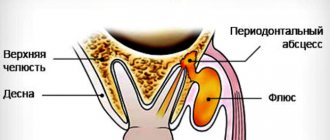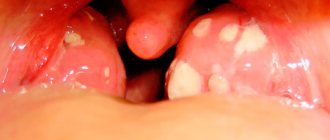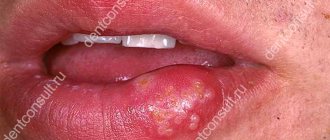Health
Watch the video if you are too lazy to read
Watch the video if you are too lazy to read
Too much mucus in the throat can be extremely unpleasant.
Accumulating phlegm causes discomfort and a feeling as if something is stuck, as well as a constant urge to clear your throat.
In many cases, the cause is an upper respiratory tract infection, but allergies, asthma, heartburn and other factors are also often culprits.
About mucus in the throat
Mucus in the throat occurs due to the abundant accumulation of phlegm.
Mucus in the throat can accumulate under the influence of various factors associated with both the external environment and diseases of the internal organs. The most common cause of mucus in the throat is diseases of the ENT organs of allergic, non-allergic, as well as bacterial, post-infectious and fungal origin. Abnormalities in the development of the nasopharynx can contribute to the development of mucus in the throat.
Persons who have excessive accumulation of mucus in the throat should be observed by an ENT doctor, since the real cause of this phenomenon is not easy to determine. The main thing is not to self-medicate, so as not to worsen the situation. Mucus in the throat can appear for various reasons. Quite often, mucus in the throat occurs due to abundant accumulation of sputum , which is the first sign of an inflammatory process in the bronchi. To make an accurate diagnosis, you need to consult a medical specialist, that is, an ENT specialist.
A characteristic sign of one of the diseases in which mucus appears in the throat is catarrhal or hypertrophic pharyngitis of a chronic nature. In this case, the inflammation that affects the pharynx area leads to the formation of a lump of mucus, which irritates the mucous membrane, causing the desire to cough.
Causes of mucus in the throat
The causes of mucus in the throat are:
- Pharyngitis (inflammation of the pharyngeal walls);
- Sinunsitis (inflammation of the paranasal sinuses);
- Adenoiditis (inflammation of the pharyngeal tonsil).
All of these diseases cause mucus to accumulate in the throat. Increased mucus production in the throat occurs with nasal polyps and a deviated nasal septum. After nasal injuries, complications such as a forced cough may appear. Mucus in the throat often accumulates after a recent illness , such as the flu or ARVI. The cause of mucus in the throat may be a banal manifestation of bronchial asthma. With a disease such as bronchial asthma, mucus is formed in large volumes as a protective reaction of the body, being a means of evacuating allergens that leave the body in this way.
The accumulation of mucus in the throat can be caused by a carbonated drink, hot, spicy or very cold food. Nicotine and alcohol have such a detrimental effect, which irritates the mucous membrane of the nasopharynx, thereby aggravating the condition. All of these factors can cause congestion, which is manifested by a sensation of mucus accumulation in the throat. Most often, this symptom is observed in the morning after waking up. At night, mucus drains down the back of the throat and accumulates in the throat as a result of prolonged exposure to a horizontal position during sleep. Cough in the morning is not accompanied by changes in the lungs, but is characterized by frequent discharge of mucus clots.
Symptoms of mucus in the throat
Typical symptoms of mucus in the throat include:
- Feeling of burning and rawness in the throat;
- Sore throat;
- Unpleasant sensations when swallowing;
- Constant desire to cough;
- Lump in throat.
Common symptoms include headaches and enlarged cervical lymph nodes. When a person begins to experience a sore throat or a pleasant sensation while swallowing, these symptoms may indicate mucus in the throat. In other words, a lump in the throat is felt due to a constant desire to cough.
The method of treating mucus in the throat is determined only by an ENT doctor after a comprehensive examination.
Why does mucus accumulate and can drain and smell in children?
Children's rhinitis is a common symptom of a cold, which very often affects the children's body. Such a symptom cannot be ignored, and to avoid the formation of serious complications, begin treatment immediately.
White
In young patients, when blowing their nose, parents discover white mucus. The reason for its formation lies in allergies. In addition to the fact that the mucus (or clot) is white, it is also viscous, viscous and can smell. The following reasons may influence the formation of allergies:
- pet fur;
- dust and very dry air;
- microorganisms that live in fleecy carpets or bedding.
To determine the exact cause of the allergy and the associated whitish nasal discharge, it is necessary for the baby to undergo a blood test. Then it will be possible to identify the allergen and prescribe it a course of antihistamine therapy.
How to properly use the sinusitis spray is indicated here.
Viscous
A poor environmental background can contribute to the accumulation of thick mucus. The baby's body actively produces mucus, which the nasal mucosa needs to prevent the negative effects of various microorganisms. The result of a large accumulation of bacteria and viruses is thick mucus. It is produced by mucin proteins and also consists of water and salt. It is this protein that is responsible for the consistency of nasal discharge. Most often, thick snot in a child is a sign of hypothermia and allergies.
You can read in detail about the use of a spray for allergic rhinitis in this material.
Green nasal discharge
The color of snot can indicate the stage and type of disease that caused it. Very often, parents begin to panic when the baby secretes green mucus. In fact, this is not a good sign, since it indicates the presence of a dangerous illness.
The following pathologies most often contribute to the release of green mucus:
- Purulent runny nose
. This disease is a complication of viral-type acute respiratory infections. Purulent rhinitis greatly weakens children's immunity, and these are ideal conditions for the development of a secondary bacterial infection. This condition cannot be cured with solutions and plenty of drinking alone, so parents should not allow the pathological process to develop. - Sinusitis
. In addition to the fact that green mucus is released from the nose, the baby’s sensitivity to taste buds decreases. The lesion can be caused not only to one, but also to both sides of the nasopharynx. The baby may have a fever, pain in the area of the affected sinus, pain in the head, which intensifies when the child takes a position lying on his back. - Frontit
. When the body is affected, the baby develops symptoms characteristic of sinusitis. The difference between these pathologies is that frontal sinusitis causes pain in the nasal sinus that is affected by the infection. - Ethmoiditis
. This disease can occur due to untimely treatment of rhinitis. The infection affects the paranasal sinuses, located in the ethmoid labyrinth. In addition to painful sensations, the baby may develop a fever, runny nose, and nasal congestion.
The link shows the causes and treatment of a sore throat.
Treatment of mucus in the throat
Treatment of mucus in the throat at the ENT-Asthma clinic is comprehensive and is aimed at suppressing local symptoms of the disease, affecting the main causes that maintain mucus in the throat. The main task of treating mucus in the throat is to eliminate discomfort. For more effective treatment, painkillers and anti-inflammatory, antiseptic and antibacterial drugs are used.
For local treatment of mucus in the throat, drugs can be used to help moisturize the mucous membrane and relieve sensations that are considered paresthesia - a feeling of soreness and tickling in the throat. In cases where mucus in the throat is a symptom of an infectious disease , atomization of the pharyngeal cavity is used using aerosols of combined action (antiseptic and analgesic). The choice of an antibacterial agent by an ENT doctor largely depends on the identified pathogen in case of moderate and severe course of the disease.
If the mucus in the throat is of an allergic nature, then our specialist doctors use a complex of antihistamines. To treat mucus in the throat, the ENT-Asthma clinic uses immunomodulators , which stimulate the body’s own forces to fight the disease. Simply put, the desired result is achieved by increasing immunity. To effectively treat mucus in the throat, sanitation of foci of infection, the oral cavity and the upper respiratory tract is indicated.
Medicine for phlegm in throat
1
Medicines that stimulate expectoration. They help mucus move through the respiratory tract and out. These include: marshmallow, thermopsis, tablets and syrup for phlegm in the throat based on licorice, coltsfoot, violets and a number of essential oils.
2
Medicines that can thin sputum (mucolytics). They will help with viscous, thick sputum that is difficult to remove. Among them are widely known: Acetylcysteine, Ambroxol, Bromhexine.
3
Homeopathic tablets, syrups and lozenges. These products, based on a complex of medicinal herbs and oils, have anti-inflammatory, expectorant and mucolytic properties. These include: Sinupret, Gelomirtol, Codelac, Tussin, Doctor Mom, etc.
4
Immunomodulators of synthetic and plant origin (eleutherococcus, IRS-19, echinacea, Ribomunil). They do not directly affect phlegm, but help to naturally increase immunity and get rid of viruses and germs.
5
Lozenges and throat sprays based on antimicrobial and antiseptic agents (Hexoral, Antiangin, Efizol, etc.). Help relieve inflammation in the oropharynx.
6
Nasal rinsing and irrigation (Humer, Aqualor) are effective if phlegm is caused by problems in the nasal cavity.
There are many remedies to treat phlegm in the throat. The choice of a specific name and the selection of a dose and treatment regimen should be carried out by a doctor. Only he can find the cause of the problem, assess the degree of neglect of the pathological process and offer the correct treatment options.











